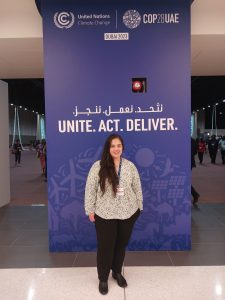For many, high school is a time of exploration and discovery, and for Kirstin Meiring, the Iimbovane holiday program she attended in 2011, held many first-time experiences. Her first steps onto Stellenbosch University’s campus, the thrill of staying in a residence, and the friendships forged with fellow learners from diverse backgrounds. It was through Iimbovane that she had her first taste of practical fieldwork at Tygerberg Nature Reserve, hunting for invertebrates and mounting specimens.
Today, as an environmental lawyer, Kirstin finds herself at the forefront of biodiversity conservation. Who would know that this hands-on introduction would lay the foundation for her future path. According to Kirstin, the Iimbovane program not only introduced her to the wonders of biodiversity but also instilled an appreciation for the importance of conservation.
“Iimbovane taught me about the importance of nature and biodiversity conservation. The program helped me to realise that conservation was a passion of mine and that it was a career path that I would be keen to follow in years to come. More than a decade later, I now find myself contributing to policy and law reform in the biodiversity conservation sector and I absolutely love every minute of it.”
After completing her law degree (LLB) at the University of Cape Town (UCT), she continued with a part-time Masters degree (LLM) in Environmental Law, alongside an internship at the South African National Biodiversity Institute (SANBI). She was thereafter appointed as a candidate attorney at a Cape Town law firm specialising in environmental, land use planning and heritage law.
Kirstin is currently Senior Programme Officer in SANBI’s Adaptation Policy and Resourcing Division, and her core functions is to contribute to national policy and legislative reform pertaining to climate change and ecosystem-based adaptation. This includes mobilizing climate finance for projects that promote sustainable farming, enhance water security, and support local communities — a role that allows her to merge her legal expertise with a passion for environmental stewardship.
However, even the easiest of journeys also has challenges. In Kirstin’s case, transitioning from high school participant to environmental lawyer came with tight deadlines, complex legal matters, and the demanding nature of the profession. One of Kirstin’s major milestones included representing South Africa at the United Nations COP28 Climate Change Conference in 2023 and advocating for SANBI’s stance on critical legislation.
Looking back on her journey, Kirstin has good advice for those considering a career in environmental law.
“As with any career, I would recommend that students read up on what their preferred degree and profession entails. If you know of any practicing lawyers request to job shadow them for a few days. Your law degree is only a steppingstone to becoming an attorney. Know what the full journey entails so that you have a realistic sense of timing when it comes to meeting your career goals.”
“As an attorney, I would consult with clients, do legal research, draft legal correspondence and attend court. Sometimes I need to attend site inspections to assess the state of the environment where a development is proposed to take place. I also met regularly with NGOs, commercial clients and private developers on a range of matters related to biodiversity conservation, renewable energy development, air quality, mining, coastal management, land use planning and heritage law.”
For Kirstin, the journey from a curious high school participant to a law professional has been both challenging and immensely rewarding. It’s a testament to the power of early engagement and the value of science outreach programs like Iimbovane.
|
|
|

